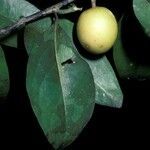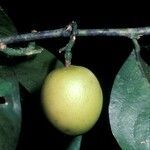Tree, to 40 m tall; young branches glabrous. Petioles 2-5(-8) mm; blades chartaceous to coriaceous, ovate to elliptic, 6-12(-15) x 2.5-5(-7) cm, apex acute to shortly acuminate, base rounded to attenuate, primary vein flat above, prominent beneath, secondary veins 4-7 per side, hardly prominulous on both sides. Racemes axillary, glabrous, finely warty, male ones 5-10 cm, female ones 1.5-3.5 cm long; bracts caducous, broadly ovate to rhombic, ca. 2 mm diam., upper half with ciliate margin; flowers usually 3 per bract with 2 very small bracteoles at the base of the pedicels of the lateral flowers. Pedicels and flowers glabrous, pedicels 0.5-2 mm long. Male flowers: tepals oblong, acute, 2-3 mm long; stamens 3 mm long, anthers oval, 0.5 mm; disc lobes fleshy, 1-1.5 mm long, apex rounded; rudimentary pistil thinly cylindric, 0.7 mm long. Female flowers: tepals 1 mm long; disc annular, fleshy, margin undulating, ca. 0.5 mm high; pistil cylindric, 1 mm long. Drupe orange, 2.5 x 2 cm, pedicel up to 4 mm long.
More
A medium sized tree. It grows 40 m tall. The bark is thick and corky. The leaves are oval or sword shaped and taper to a short tip. They are 6-12 cm long by 2.5-5 cm wide. The flowers are in the axils of leaves. The fruit is yellow and fleshy with a stone inside.



